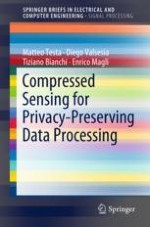The objective of this book is to provide the reader with a comprehensive survey of the topic compressed sensing in information retrieval and signal detection with privacy preserving functionality without compromising the performance of the embedding in terms of accuracy or computational efficiency. The reader is guided in exploring the topic by first establishing a shared knowledge about compressed sensing and how it is used nowadays. Then, clear models and definitions for its use as a cryptosystem and a privacy-preserving embedding are laid down, before tackling state-of-the-art results for both applications. The reader will conclude the book having learned that the current results in terms of security of compressed techniques allow it to be a very promising solution to many practical problems of interest. The book caters to a broad audience among researchers, scientists, or engineers with very diverse backgrounds, having interests in security, cryptography and privacy in information retrieval systems. Accompanying software is made available on the authors’ website to reproduce the experiments and techniques presented in the book. The only background required to the reader is a good knowledge of linear algebra, probability and information theory.
